Cherries and apples are both well suited for California’s Lodi district, located in northern San Joaquin Valley. Jeff Colombini of Lodi Farming, Inc., grows about 500 acres of apples and 300 acres of cherries in an area marked by having cooler summer temperatures than other locations in the same valley.
For many decades, Lodi district growers enjoyed being the first cherries harvested in the United States and received a premium for their early market window. Quality and yield weren’t as important then because retailers were eager for the first cherries of the season, Colombini explained.
But when Colombini took over at the farm management company in 1992, he knew fruit quality would be an important factor in the cherry industry’s future. He made the first of his many trips to the Pacific Northwest in 1993 to learn how to improve cherry quality.
2013 Grower of the Year
“When I was a kid, we packed cherries under a shade tree without hydrocooling. I once heard an Oregon cherry grower say that ‘California growers could have painted rocks red then and still been able to sell them.'”
But dramatic changes have occurred in California’s sweet cherry production in the last couple of decades.
New varieties are more heat tolerant, have lower chilling requirements, and more importantly, don’t spur and double with high summer temperatures. Cherries are now grown from Bakersfield to Yuba City, and other nontraditional places. More than 40,000 acres of cherries are planted statewide. Lodi is no longer first.
“With growing districts south of Lodi now coming in first, I’ve had to learn how to grow cherries like the Northwest does,” he said.
Colombini grows Chelan, Index, Bing, Coral Champagne, and Rainier cherry varieties. Trees are trained to the steep leader system with four to six leaders.
He has new varieties, rootstocks, and training systems under test in his experimental block, including his version of a newly developed system by Washington State University researchers called the UFO (Upright Fruiting Offshoots). California growers, like their northern counterparts, are searching for dwarfing, precocious rootstocks to grow more pedestrian-friendly trees.
Of the 20 different rootstocks in his trial, one of the more promising dwarfing stocks is Gisela 12. It’s one of the least dwarfing of the Gisela rootstocks, but one of the more productive ones. He’s found that G.5 and G.6 are too dwarfing in his soil and climate conditions, and trees runt out after a few years.
More Stories |
| – Grower has an open door |
California’s apple industry, which annually ships from two to three million boxes, represents a small sliver of the nation’s apple production. The state is ranked fifth among leading apple-producing states, but is the number-two apple exporter behind Washington. About one third of the crop is exported, one third consumed in local markets, and the remainder sold across the country.
Apple production is more difficult in California than locations in the Northwest, Colombini believes, noting that growers must intensively manage orchards. “You need to be using productive orchard training systems, but also techniques like overhead cooling for sunburn protection and reflective material for color enhancement.”
Why bother with such a challenging crop?
It’s all about timing, he said. “We fill a tiny market niche, but it’s an important one. Our advantage is that we can provide retailers with a fresh applebefore Washington starts. When we come on, retailers have a choice of a California apple that’s a few days old, a Chilean apple six months old, or Washington apples 11 months old. We want to get the crop picked, packed, shipped and sold before Washington comes on strong.”
Colombini grows the state’s mainstay apple varietiesGala, Fuji, Granny Smith, and Cripps Pink. Gala, the first variety picked, does well because retailers are eager for the new crop. California shippers aim to move the variety quickly before Washington’s Gala crop hits full steam. Also, Gala fit a labor window in early August when the labor supply is more available.
Cripps Pink (also sold under the Pink Lady trademark) is another good fit for California, he said, noting that fruit have a balanced sugar-to-acid ratio when picked and don’t require several weeks of cold storage to improve eating quality.
Colombini has several proprietary varieties under trial, including a number of Honeycrisp strains.
Colombini has borrowed techniques from the Northwest to improve his apple quality, as well as to grow large, high-quality cherries.
“Nobody knew how to grow apples here in the 1970s and 80s,” he said. “We were emulating the Northwest. It was monkey see, monkey do, and we were implementing techniques from other regions before we really understood the growing differences and challenges in California.”
He pointed to sunburn as an example of regional differences. “Sunburn in California occurs because of hot temperatures, but in the Northwest, high ultraviolent radiation is also a factor. We both get sunburn, but for different reasons. We’ve learned that evaporative overhead cooling works better for us than sunburn protectants.”
Rootstocks are another example. Malling 9, a semidwarfing rootstock, is widely used in the Northwest. In California, M.7 is the rootstock of choice because M.9 delays maturity. “Our niche is built on being early, so anything that delays maturity is a problem for us.”
Learn by doing
The motto of his college alma mater, Cal Poly, is ‘Learn by doing.’ It’s a principle Colombini applies to growing as he learns what does best in his conditions. “There are certain things that we have just had to figure out for ourselves,” he said, adding that mistakes will be made and he’s learned things the hard way.
The central leader is one of Colombini’s learning experiences.
The late Buck Lewis and his son Mark of Sierra Hills Packing, modern-day California apple-growing pioneers, traveled to the Northwest in the early years (1970s-80s) to learn orchard training systems. Colombini said they brought the central leader training system to California, and it was widely adopted in orchards planted 20 years ago.
He’s spent the last several years converting his central leader orchards to the V-trellis system. Of Lodi Farming’s 500 acres of apples, he’s down to the last 25 acres that await conversion. Some of the converted blocks also were grafted to newer strains during the conversion process, including many of the Gala blocks updated to the Buckeye strain.
Colombini found that under their growing conditions, the central leader results in trees that are too vigorous. “We just can’t get the production on a central leader that we can on a V because of the light penetration,” he said. “Nor can we get the color with a central leader.” Pruning is also easier in V-trellis systems, and trees are better suited for platforms and mechanical harvesting equipment.
“With the central leader, we had to use reflective fabric in all the orchards to help color the lower hanging fruit,” Colombini added. “Now, I only use reflective covers in Pink Lady
Conversion to a V-trellis is an ugly process. In the first year, uprights or limbs are allowed to grow out the bottom of the tree. Colombini aims to bring out four to five whorls or branches for each side, giving the tree eight to ten scaffolds or leaders. In the second year, after harvest, the central leader is cut out of the middle and additional training wires are added.
Conversion is a one- to two-year process before the tree is back in full production, depending on whether scion wood also is changed. In a Gala block where only the training system was changed, the central leader was cut out after harvest in 2012. This year, its first on the V-trellis, production was 53 bins per acre.
“If it was still on the central leader, 53 bins would be considered a good yield,” he said. Next year, he hopes to hit around 75 bins per acre, his target yield for Gala on the V-trellis. Target yields for Fuji and Pink Lady (Cripps Pink) are 80 bins per acre; Granny Smith is in the 75-bin range. •

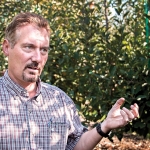
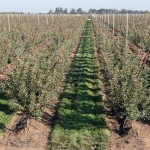
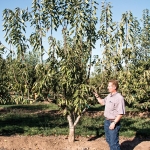
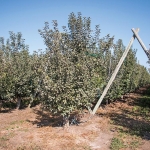
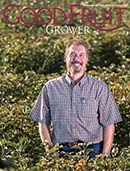





Leave A Comment